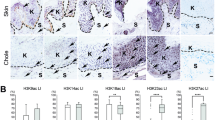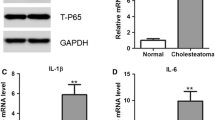Abstract
Etiopathogenesis of acquired and congenital cholesteatoma is still unclear. The clinical behavior of adult acquired, pediatric acquired and congenital cholesteatomas show differences. The scope of the this study was to detect the matrix metalloproteinase (MMP), tissue inhibitors of metalloproteinase (TIMP) and epidermal growth factor receptor (EGFR) gene expression changes in cholesteatoma perimatrix and to compare these changes among congenital cholesteatoma, adult acquired cholesteatoma and pediatric acquired cholesteatoma. A total of 16 genes including MMPs, TIMPs and EGFR were analyzed in the samples of 32 cholesteatoma tissues. Real-time PCR was used for detection of the gene expression levels. Data analyses were achieved by ΔΔCT method (Light Cycler 480 Quantification Software) and Statistical Package for Social Sciences (SPSS) version 22.0. The expression levels of MMP-2, -9, -10, -11, -13, -14, -15, -16 and EGFR genes were significantly higher in acquired cholesteatoma than healthy tissue (p < 0.05). There was a statistically significant decrease (3.34 times more) in the mean TIMP-2 gene expression level in acquired cholesteatoma compared to healthy tissue (p < 0.05). There was a significant increase in the mean expression level of MMP-7 gene and a decrease in the mean expression level of TIMP-1 gene (3.12 times more) in congenital cholesteatoma compared to healthy tissue (p < 0.05). This study indicates that increased expression levels of some particular MMP genes and EGFR gene and decreased expression levels of TIMP genes may play an important role in the development of cholesteatoma. Further, MMP-9, MMP-13 and MMP-14 genes may have a remarkable role in the development of more aggressive cholesteatoma forms. The authors concluded that overexpression of MMP-9, MMP-13 and MMP-14 may cause stronger inflammation associated with cholesteatoma.
Similar content being viewed by others
Data availability
The datasets analysed during the current study are available from the corresponding author on reasonable request.
References
Yung M, Tono T, Olszewska E, Yamamoto Y, Sudhoff H, Sakagami M et al (2017) EAONO/JOS joint consensus statements on the definitions, classification and staging of middle ear cholesteatoma. J Int Adv Otol 13(1):1–8
Tokuriki M, Noda I, Saito T et al (2003) Gene expression analysis of human middle ear cholesteatoma using complementary DNA arrays. Laryngoscope 113(5):808–814
Miyao M, Shinoda H, Takahashi S (2006) Caspase 3, caspase 8 and nuclear factor-kappa B expression in human cholesteatoma. Otol Neurotol 27(1):8–13
Banerjee AR, James R, Narula AA, Lee RJ (1998) Matrix metalloproteinase-1 in cholesteatoma, middle ear granulations and deep meatal skin: a comparative analysis. Clin Otolaryngol 23:515–519
Schmidt M, Grunsfelder P, Hoppe F (2000) Induction of matrix metalloproteinases in keratinocytes by cholesteatoma debris and granulation tissue extracts. Eur Arch Otorhinolaryngol 257:425–429
Shibosawa E, Tsutsumi K, Takakuwa T, Takahashi S (2000) Stromal expression of matrix metalloprotease-9 in middle ear cholesteatomas. Am J Otol 21:621–624
Schönermark M, Mester B, Kempf HG, Bläser J, Tschesche H, Lenarz T (1996) Expression of matrix-metalloproteinases and their inhibitors in human cholesteatomas. Acta Otolaryngol 116(3):451–456
Suchozebrska-Jesionek D, Szymański M, Kurzepa J, Gołabek W, Stryjecka-Zimmer M (2008) Gelatinolytic activity of matrix metalloproteinases 2 and 9 in middle ear cholesteatoma. J Otolaryngol Head Neck Surg 37(5):628–632
Morales DSR, Penido NO, Silva IDCG, Stávale JN, Guilherme A, Fukuda Y (2007) Matrix metalloproteinase 2: an important genetic marker for cholesteatomas. Braz J Otorhinolaryngol 73(1):55–61
Migirov L, Weissburd S, Wolf M (2010) Mastoidectomy in the elderly. ORL J Otorhinolaryngol Relat Spec 72(2):80–83
Jin BJ, Min HJ, Jeong JH, Park CW, Lee SH (2011) Expression of EGFR and microvessel density in middle ear cholesteatoma. Clin Exp Otorhinolaryngol 4(2):67–71. https://doi.org/10.3342/ceo.2011.4.2.67
Alves AL, Pereira CSB, Carvalho MDFP, Fregnani JHTG, Ribeiro FQ (2012) EGFR expression in acquired middle ear cholesteatoma in children and adults. Eur J Pediatr 171(2):307–310
Palkó E, Póliska S, Sziklai I, Penyige A (2018) Analysis of KRT1, KRT10, KRT19, TP53 and MMP9 expression in pediatric and adult cholesteatoma. PLoS One 13(7):e0200840. https://doi.org/10.1371/journal.pone.0200840
Klein D (2002) Quantification using real-time PCR technology: applications and limitations. Trends Mol Med 8:257–260
Rifkin BR, Vernillo AT, Golub LM, Ramamurthy NS (1994) Modulation of bone resorption by tetracyclines. Ann NY Acad Sci 732:165–180
Palkó E, Póliska S, Csákányi Z et al (2014) The c-MYC protooncogene expression in cholesteatoma. Biomed Res Int 2014:639896. https://doi.org/10.1155/2014/639896
Rezende CE, Souto RP, Rapoport PB, Campos Ld, Generato MB (2012) Cholesteatoma gene expression of matrix metalloproteinases and their inhibitors by RTPCR. Braz J Otorhinolaryngol 78(3):116–121
Wu Y, Tang X, Shao W, Lu Y (2019) Effect of CT manifestations of cholesteatoma on MMP-2, MMP-9 and IL-6 in the serum of patients. Exp Ther Med 17(6):4441–4446. https://doi.org/10.3892/etm.2019.7484
Mehta D, Daudia A, Birchall JP, Banerjee AR (2007) The localization of matrix metalloproteinases-8 and-13 in cholesteatoma, deep-meata land postauricular skin: a comparative analysis. Acta Otolaryngol 127(2):138–142
Murphy G, Willenbrock F, Crabbe T et al (1994) Regulation of matrix metalloproteinase activity. Ann NY Acad Sci 732:31–41
Kobayashi H, Asano K, Kanai K, Suzaki H (2005) Suppressive activity of vitamin D3 on matrix metalloproteinase production from cholesteatoma keratinocytes in vitro. Mediat Inflamm 2005(4):210–215. https://doi.org/10.1155/MI.2005.210
Vivanco I, Sawyers CL (2002) The phosphatidylinositol 3-kinase AKT pathway in human cancer. Nat Rev Cancer 2:489–501
Lynrah ZA, Bakshi J, Panda NK, Khandelwal NK (2013) Aggressiveness of pediatric cholesteatoma. Do we have an evidence? Indian J Otolaryngol Head Neck Surg 65(3):264–268. https://doi.org/10.1007/s12070-012-0548-z
Dornelles CC, daCosta SS, Meurer L, Rosito LP, da Silva AR, Alves SL (2009) Comparison of acquired cholesteatoma between pediatric and adult patients. Eur Arch Otorhinolaryngol 266:1553–1561
Mallet Y, Nouwen J, Locomte-Houcke M, Desaulty A (2003) Aggressiveness and quantification of epithelial proliferation of middle ear cholesteatoma by M1B1. Laryngoscope 113:328–331
Morita Y, Takahashi K, Izumi S et al (2017) Risk factors of recurrence in pediatric congenital cholesteatoma. Otol Neurotol 38:1463–1469
Zarrabi K, Dufour A, Li J et al (2011) Inhibition of matrix metalloproteinase 14 (MMP-14)-mediated cancer cell migration. J Biol Chem 286(38):33167–33177. https://doi.org/10.1074/jbc.M111.256644
Funding
Not applicable.
Author information
Authors and Affiliations
Corresponding author
Ethics declarations
Conflict of interest
The authors declare that they have no competing interests.
Ethics approval and consent to participate
This study was approved by the institutional review board of the tertiary academic center. For human specimen collection, informed consent was obtained from all the participated adults or parents of children in written form as per the institutional ethics committee approval. No animal were used for this research.
Consent for publication
Consent forms for publication of surgical and radiological images were obtained from individuals.
Additional information
Publisher's Note
Springer Nature remains neutral with regard to jurisdictional claims in published maps and institutional affiliations.
Rights and permissions
About this article
Cite this article
Kaya, İ., Avcı, Ç.B., Şahin, F.F. et al. Evaluation of significant gene expression changes in congenital and acquired cholesteatoma. Mol Biol Rep 47, 6127–6133 (2020). https://doi.org/10.1007/s11033-020-05689-9
Received:
Accepted:
Published:
Issue Date:
DOI: https://doi.org/10.1007/s11033-020-05689-9




